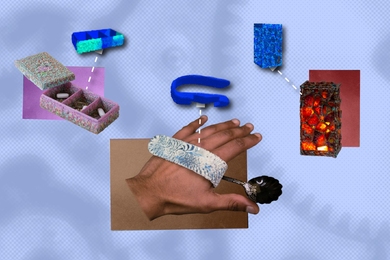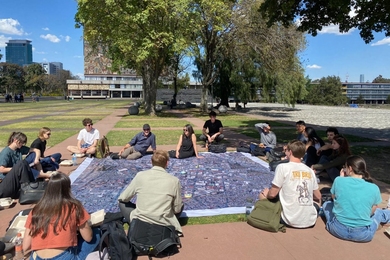Fifteen years ago, Diana Dabby was enjoying a flourishing career as a pianist and composer, performing in New York's Weill (Carnegie) Recital Hall and abroad. Then one day she found a series of articles on computer music -- all written by mathematicians, computer scientists or electrical engineers -- which led her back to college and into the field of engineering. In 1987 she became a graduate student in MIT's Department of Electrical Engineering and Computer Science (EECS) and in 1995 received the PhD for her thesis, "Musical Variations from a Chaotic Mapping."
Dr. Dabby has taught EECS courses in acoustics, signals and systems, and circuits and electronics and was artist-in-residence there from 1996-97. She is currently a postdoctoral associate in EECS as well as visiting assistant professor in music at Middlebury College in Vermont.
On Monday, March 30 at 4pm in Rm 34-100, Dr. Dabby will discuss and demonstrate her technique for generating musical variations of an original piece in a lecture/performance titled, "Art Intersects Science: Musical Variations from a Chaotic Mapping." Last week, Mary Haller of the Office of the Arts asked her about her work.������������������
MH: You were active as a professional musician for many years. What led you to MIT and to your interest in chaos theory?
DD: Back in the '80s I was earning my living as a concert pianist in New York, realizing that a technological revolution was swirling around me. I couldn't help but wonder what might arise if a professional musician acquired, as a second language, the language of science. So I taught myself algebra and, as a pianist, put myself through engineering school at the City College of New York. I then got admitted to several graduate schools, including MIT, and took the train up to Boston to check it out. I parked myself at the crosswalk between Lobby 7 and the Student Center and noticed a kind of intensity, a sense of purpose in the students there. That resonated with me.
The person who led me to chaos theory was George Verghese. I had signed up for his Dynamic Systems class. One day he walked into class and handed me a journal devoted to chaos, saying, "You're an artist. What would you do with this?" Though I didn't understand everything in that journal, I understood enough to realize there was something here for music. So I plunged into it.
What is "chaotic mapping" and how have you applied it to music?
In chaos, we have something known as a "strange attractor" which basically attracts any orbit in 3-D space, provided the orbit is near enough. These orbits have a distinguishing property: they are very sensitive to where they start, traversing different paths depending on initial values. Yet the differing paths are always trying to get closer to the portrait of the strange attractor.
In my variation technique, the attractor represents the original musical piece and the neighboring orbits represent the possible variations on it. I envisioned the original musical piece as 'riding the back of' the strange attractor. Then I invented a chaotic mapping to generate different variations via a map from a chaotic orbit onto the original piece. The musical variations that result can be close to the original, mutate almost beyond recognition, or achieve degrees of variability between these extremes.
The technique can also be used to infuse a given work with the attributes of another, so that, for instance, a work by Bach can acquire attributes of a work by Gershwin.
How would a composer make use of this technique?
The variation technique is used by a composer after a work has been completed. The composer finishes writing his or her piece and then uses the technique to go on a journey with that piece, perhaps to someplace new or unimagined. It's a tool, an idea generator.
How have composers responded to this method of generating musical variations?
They want the software -- a pretty strong endorsement! Mostly, composers respond with great enthusiasm. Performers have also shown excitement. At other times, there is a response like, "I'm not interested in this. Let me hear some music that you've written." And that's fine too because I get to show another part of my work.
How has your research affected the way you as a musician now listen to or play music?
The work I have done with chaos theory and music has been responsible for the growth of multiple paths within my own musical work. It sparked a return to counterpoint which has become a real passion.
What other applications might there be for chaotic mapping?
Currently I'm applying it to image. Others have applied it to dance. Some biologists have been curious about applications to DNA sequencing. Neurophysiologists have been interested in determining whether variations in data are random or deterministic. If a chaotic mapping were found to underlie the variants, then clearly the system under study would be deterministic.
What has the environment at MIT been like for you and your research?
I've been fortunate to be in EECS, which has historically been an innovative department. They gave me a long rope and I ran with it. I've been very inspired by the students, staff and faculty of the Laboratory for Information and Decision Systems. The place hums with a mix of brilliance, humor and collegial ease that makes it an ideal working environment for me. I am also indebted to the UROP program and to my students who always seem to have the right stuff.
A version of this article appeared in MIT Tech Talk on March 18, 1998.





